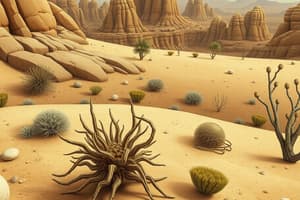Podcast
Questions and Answers
Even when equilibrium is reached, molecules stop moving.
Even when equilibrium is reached, molecules stop moving.
False (B)
Which of the following factors does NOT increase the rate of diffusion?
Which of the following factors does NOT increase the rate of diffusion?
A ______ concentration gradient will result in a faster rate of diffusion.
A ______ concentration gradient will result in a faster rate of diffusion.
steeper
Explain how a larger surface area can increase the rate of diffusion.
Explain how a larger surface area can increase the rate of diffusion.
Signup and view all the answers
Match the following factors with their effect on the rate of diffusion:
Match the following factors with their effect on the rate of diffusion:
Signup and view all the answers
Which of the following is MOST likely to have a faster diffusion rate?
Which of the following is MOST likely to have a faster diffusion rate?
Signup and view all the answers
Why is the adaptation in the figure described only found in larger organisms and not smaller ones like amoeba?
Why is the adaptation in the figure described only found in larger organisms and not smaller ones like amoeba?
Signup and view all the answers
Diffusion is the only method for transport in larger organisms.
Diffusion is the only method for transport in larger organisms.
Signup and view all the answers
All adaptations are visible.
All adaptations are visible.
Signup and view all the answers
The larger the surface area, the faster the rate of diffusion.
The larger the surface area, the faster the rate of diffusion.
Signup and view all the answers
The thicker a surface/membrane is, the longer it takes for diffusion.
The thicker a surface/membrane is, the longer it takes for diffusion.
Signup and view all the answers
All organisms have specialized structures to aid diffusion.
All organisms have specialized structures to aid diffusion.
Signup and view all the answers
What is the main advantage of a larger surface area for diffusion?
What is the main advantage of a larger surface area for diffusion?
Signup and view all the answers
The movement of particles from a region of ______ concentration to a region of ______ concentration is known as diffusion.
The movement of particles from a region of ______ concentration to a region of ______ concentration is known as diffusion.
Signup and view all the answers
Which of the following is NOT a factor that affects the rate of diffusion?
Which of the following is NOT a factor that affects the rate of diffusion?
Signup and view all the answers
Match the following terms with their definitions:
Match the following terms with their definitions:
Signup and view all the answers
Which of the following best describes the surface area to volume ratio (SA:V)?
Which of the following best describes the surface area to volume ratio (SA:V)?
Signup and view all the answers
A larger surface area to volume ratio leads to slower diffusion rates.
A larger surface area to volume ratio leads to slower diffusion rates.
Signup and view all the answers
Explain how the surface area to volume ratio affects the ability of an organism to obtain nutrients and oxygen.
Explain how the surface area to volume ratio affects the ability of an organism to obtain nutrients and oxygen.
Signup and view all the answers
Larger organisms need specialized structures like organs and organ systems because they cannot rely on ______ alone to deliver nutrients and oxygen to all their cells.
Larger organisms need specialized structures like organs and organ systems because they cannot rely on ______ alone to deliver nutrients and oxygen to all their cells.
Signup and view all the answers
Why do larger organisms have more cells than smaller organisms?
Why do larger organisms have more cells than smaller organisms?
Signup and view all the answers
Specialized organ systems in larger organisms are designed to counteract the limitations imposed by diffusion.
Specialized organ systems in larger organisms are designed to counteract the limitations imposed by diffusion.
Signup and view all the answers
Match the following terms with their corresponding explanations:
Match the following terms with their corresponding explanations:
Signup and view all the answers
Why do cells need to divide as they grow?
Why do cells need to divide as they grow?
Signup and view all the answers
Which of the following is an example of a physiological adaptation?
Which of the following is an example of a physiological adaptation?
Signup and view all the answers
Xerophytes are plants that require a lot of water to survive.
Xerophytes are plants that require a lot of water to survive.
Signup and view all the answers
What is homeostasis?
What is homeostasis?
Signup and view all the answers
An example of a behavioral adaptation is when wolves ___ in packs.
An example of a behavioral adaptation is when wolves ___ in packs.
Signup and view all the answers
What is diffusion?
What is diffusion?
Signup and view all the answers
Behavioral adaptations are physical changes an organism undergoes to survive.
Behavioral adaptations are physical changes an organism undergoes to survive.
Signup and view all the answers
Provide an example of a physical adaptation in animals.
Provide an example of a physical adaptation in animals.
Signup and view all the answers
Study Notes
Guiding Questions: Organism Size and Environment
- Organism size affects its relationship with the environment due to space and time distribution, and internal/external structures.
- Larger organisms face challenges in transporting nutrients efficiently throughout their bodies, impacting their ability to adapt to various climates.
- Adaptations (behavioral, physical, or physiological) help organisms survive in their environment.
- Behavioral adaptations include changes in habits, like hibernating.
- Physical adaptations include physical features like thicker skin for insulation.
- Physiological adaptations maintain homeostasis, ensuring internal stability.
Defining Key Terms
- Environment: The surroundings in which an organism lives and interacts.
- Adaptations: The process by which an organism becomes better suited to its environment.
- Behavioral Adaptations: Natural responses that allow organisms to survive—e.g., hunting strategies and behaviors to respond to the environment.
- Physiological Adaptations: Internal processes that maintain homeostasis, like regulating body temperature.
- Homeostasis: A self-regulating process in organisms to maintain internal stability.
- Xerophytes: Plants that don't require water to survive.
Physical, Behavioral, and Physiological Adaptations
- Behavioral adaptations: Wolves hunting in packs, humans shivering.
- Physiological Adaptations: Snakes' skin camouflaging from predators.
Diffusion
- Diffusion is the movement of substances across a cell membrane.
- Molecules move from higher to lower concentration until equilibrium is reached.
- Equilibrium doesn't stop molecular movement, but movement is balanced.
Factors Affecting Diffusion Rate
- Temperature: Higher temperatures increase molecular movement, speeding up diffusion.
- Surface Area: Larger surfaces for diffusion make the process faster.
- Thickness: Thin membranes allow quicker diffusion across a surface than thicker ones.
- Concentration Gradient: A larger difference in concentrations between areas results in faster diffusion, helping it reach equilibrium quickly.
Concentration Gradient
- The concentration gradient determines the rate of diffusion.
- Higher gradients drive molecules to diffuse at a faster rate to reach equilibrium.
- As molecules get closer to equilibrium, the rate of diffusion decreases.
Human Breathing System (Figure 4.8)
- The image demonstrates how diffusion occurs in humans.
Adaptations in Larger Organisms
- Large organisms (humans, animals) have adaptations to transport nutrients efficiently due to their complex body systems.
- Simple organisms (amoebas) rely on simple diffusion.
True or False Statements
- All adaptations are visible: False
- Larger surface area: faster diffusion: True
- Thicker membranes: slower diffusion: True
- All organisms have specialized structures for diffusion: False
- Single-celled organisms rely on simple diffusion: True
Concentration Gradient: Definition
- The concentration gradient is the difference in concentration of a substance across a space.
- The gradient drives molecules across spaces from high concentration regions to low concentration until equilibrium is reached.
Surface Area to Volume Ratio
- The surface area to volume (SA/V) ratio relates surface area to volume.
- In larger organisms, the SA/V ratio gets smaller as they grow.
- To counteract the smaller SA/V, large organisms have organs and systems.
- This helps transport nutrients and oxygen to cells and expel waste faster.
Cell Division
- Cell division is necessary because cells grow, and the SA/V ratio decreases.
- A reduced ratio hinders efficient nutrient and waste exchange in larger cells.
- Increased division prevents these limitations and enables cells to function properly.
Studying That Suits You
Use AI to generate personalized quizzes and flashcards to suit your learning preferences.
Related Documents
Description
Explore how organism size impacts their relationship with the environment, including the challenges larger organisms face in nutrient transport and adaptation. This quiz covers various types of adaptations—behavioral, physical, and physiological—that help organisms survive in different climates.




